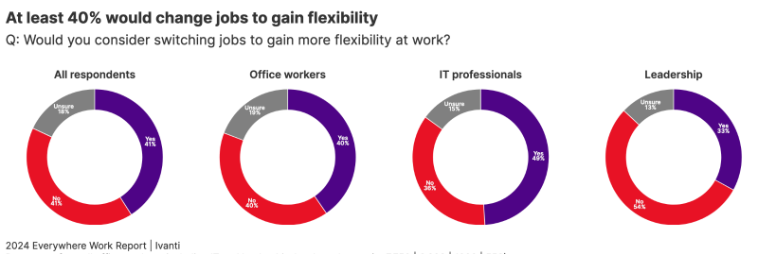Work Flexibility: It’s About More than Being Remote
Have the concepts of “work” and “workplace” ever seen as much change as they have in the past five years? These changes have driven a corresponding shift in employee attitudes toward work.
The Great Resignation may have been the first highly visible indication that something organizations and workers had never experienced was afoot. It laid to rest any notion that every employee was grateful to be tethered to a desk in a locked-down location from nine to five.
There were many explanations offered for the Great Resignation, from burnout to wage stagnation. But the fact it happened on such a large scale was evidence of a real sea-change in peoples’ attitudes toward work.
For many of them, hybrid and remote work presented a welcome new option. Everywhere Work had arrived, bringing with it a wave of change in how we perceive and define workplace flexibility.
But what does flexibility really mean in the modern workplace? How are employees and employers navigating this new paradigm?
Work flexibility: What do employees want?
Make no mistake, workplace flexibility is more than just a buzzword. It's becoming a core aspect of employment that workers are demanding.
Employees have always expected competitive pay, strong benefits, time off and more. But now flexibility has become a key factor in the employment equation.
In recent Ivanti research, a staggering 40% of office workers and 49% of IT workers said they’re willing to quit their jobs for more flexibility, highlighting just how valued it's become.
The message is clear: To attract and retain top talent, offering flexibility is no longer optional – it's fundamental. But this extends beyond working from different places – whether the office or at home or that favorite coffee bar up the street. This isn’t about where we work anymore – the focus has shifted to when and how we work. And that’s where there’s a looming disconnect that employers need to bridge.

The flexibility disconnect and workplace adaptability
Despite the overwhelming desire for flexible working conditions, there's a significant gap between what employees value and what employers offer. Our research found that while 80% of employees say flexible working is highly valuable to them, only 25% describe their current work situation as “highly flexible.”
A discrepancy this large represents a serious flexibility disconnect between employees and employers, raising questions about the readiness of workplaces to adapt to what workers want.
Employers need to confront it, though, because a high level of work flexibility is non-negotiable for many professionals – often more important to them than working remotely. They're demanding control over their work settings and circumstances, from their daily schedules to the option to knock off early or work from wherever they choose.
Managers need to realize that employees don't view these as just desirable perks they should be expected to justify or earn. They're baseline expectations among high-value professionals. Employers must be ready to accommodate them.
Learn more: 2024 Everywhere Work Report – Empowering Flexible Work
The gender divide in workplace flexibility
The demand for flexible work also spotlights the importance of diversity, equity and inclusion in the workforce, particularly when considering the divergent priorities of men and women. Sixty-five percent of women in our report told us they highly value flexible work hours, versus 54% of men.
This gender divide underlines how employers should have plenty of latitude in how they deliver flexibility to accommodate the diverse requirements of different employees. For even a flexible work environment to be inclusive, how it defines flexibility can’t be one-size-fits-all.
Beyond this, using the right tools to enable flexibility via better digital employee experiences helps bring different groups of employees together in positive ways by solving their respective remote/hybrid work challenges.
Independence, respect and the future
Look long and hard at the expectations of knowledge workers and it’s obvious they have a strong desire for greater independence and respect from employers.
For instance, a remarkable 81% of them believe that the location of their work shouldn't matter as long as it's done well. But 46% view an employer's inflexibility about their schedule as a sign of disrespect, and that’s an issue companies need to deal with if they value those workers.
The overwhelming consensus among those workers (79%) is that allowing people to work anywhere is not just a trend, it’s the future of professional employment.
What part does IT play?
HR professionals know they play a key role in enabling the flexibility employees expect. They also know it can only become a reality with a progressive IT department. By using current and effective technology to keep the company and its data safe and secure, IT can empower seamless Everywhere Work – and help HR improve its own service delivery, too.
A company’s tech stack must integrate solutions that let employees, IT and security teams enjoy secure, productive remote and hybrid work no matter where, when and how it’s being done. When an enterprise lacks that strong IT backbone, it also lacks a fundamental building block of post-COVID productivity, competitiveness and worker acquisition and retention.
To sum up: It’s not entirely accurate to say the future of work is flexible. For many professionals, the flexible future is already here – and it’s going play a big part in driving their decisions about where they want to take their talents.
